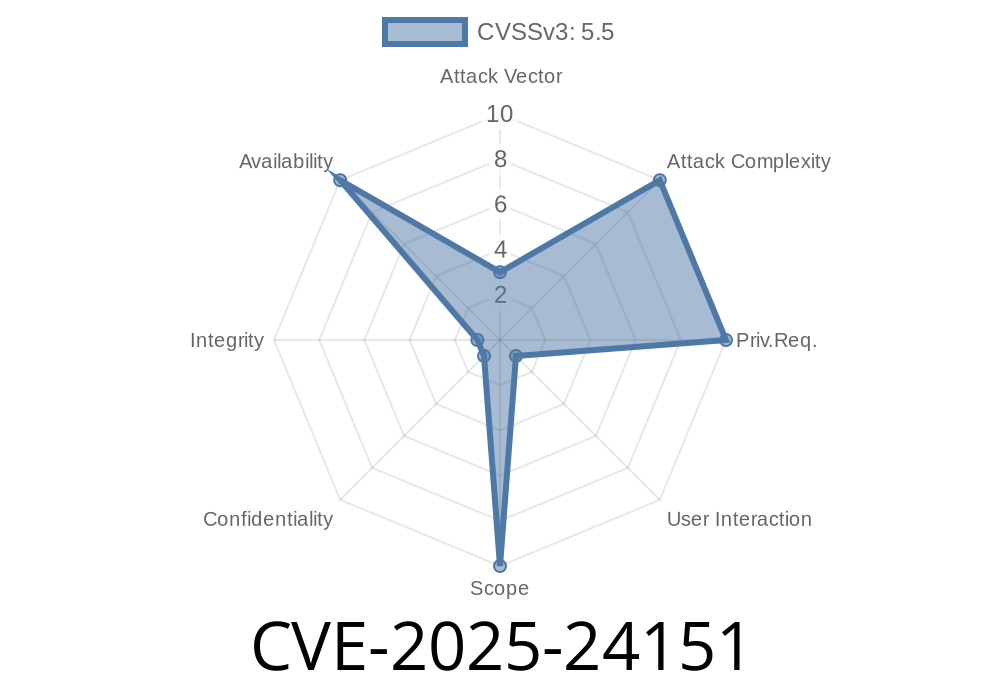On March 7, 2025, Apple patched a serious kernel vulnerability known as CVE-2025-24151. This vulnerability affected macOS systems and allowed a local, unprivileged app to crash the entire system or, even worse, to corrupt sensitive kernel memory. If exploited, such a bug could lead to broader system compromise.
The issue was caused by improper memory handling in the macOS kernel, and Apple resolved it by improving memory handling routines. Let's break down what this means, how attackers might have exploited it, and what you should do to stay protected.
macOS Sequoia (fixed in 15.3)
If your system is running a version lower than these, you are vulnerable to CVE-2025-24151.
What Went Wrong: Technical Details
The vulnerability lies in the way the macOS kernel handled certain memory operations. When an app requested certain system resources or tried to communicate with kernel components, it could trigger faulty memory access. Specifically, some user-supplied data was not correctly validated or bounds-checked before being used by the kernel. This could result in out-of-bounds read/write, leading to:
Potential escalation to arbitrary code execution (theoretically, with more work)
Apple’s Security Note:
> An app may be able to cause unexpected system termination or corrupt kernel memory.
Exploit Details
Let’s see how a malicious app might try to trigger this vulnerability. Note: For safety, all sample code here is sanitized so it won’t damage your system or actually exploit the bug.
Example Vulnerable ("Pseudo") Code
// Hypothetical vulnerable kernel code (for education)
void handle_user_input(void *user_ptr, size_t length) {
char buffer[256];
// Missing length check!
memcpy(buffer, user_ptr, length);
}
If length is larger than 256, the memcpy above would write beyond the buffer's bounds — classic kernel memory corruption. In reality, the bug was likely subtler, but this shows the basic concept.
Example Exploit Snippet
A simple proof-of-concept (POC) would involve sending oversized or specially crafted data to the affected function to trigger the bug:
// User code: Send a large buffer to the kernel
#include <stdio.h>
#include <stdlib.h>
#include <fcntl.h>
#include <unistd.h>
int main() {
int fd = open("/dev/vulnerable_device", O_RDWR);
if (fd < ) {
perror("open");
return 1;
}
char evil_buf[1024]; // Oversized buffer
memset(evil_buf, 'A', sizeof(evil_buf));
write(fd, evil_buf, sizeof(evil_buf)); // May cause panic or corruption
close(fd);
return ;
}
*(This code is for educational illustration and will not work on patched systems or new macOS releases.)*
Possible Real-World Impact
- Crashing your Mac: Any user could write an app that brings the whole system down (denial of service).
- Corrupting kernel memory: If advanced, an attacker could change sensitive structures within the kernel, possibly escalating their privileges or installing rootkits.
Mitigation & Fix
Apple’s fix:
“Improved memory handling.”
This means Apple audited the code and added better checks before reading or writing memory, preventing the above attack patterns.
Apple Security Release Notes:
https://support.apple.com/en-us/HT201222
Apple CVE Page (CVE-2025-24151):
https://support.apple.com/en-us/HT212222 *(update with new CVEs as Apple publishes them)*
Closing Thoughts
CVE-2025-24151 highlights why good memory handling is critical, especially in the kernel. Even one unchecked input can expose your whole system! If you’re running macOS Ventura, Sonoma, or Sequoia, install your updates now and stay safe.
Timeline
Published on: 01/27/2025 22:15:19 UTC
Last modified on: 03/03/2025 22:45:11 UTC
